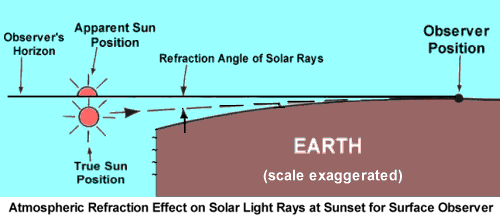 |
 |
| Home | Welcome | What's New | Site Map | Glossary | Weather Doctor Amazon Store | Book Store | Accolades | Email Us |
 | |||||||||
Equal Night and Day?Q: My class has been following the sunrise and sunset times as we approached the autumn equinox. However, on the reported first day of autumn, when the day length is supposed to be equal to that of the night at twelve hours. However, on that day, the reported sunrise was 6:47 AM and sunset at 6:57 PM, which gives a day length of 12 hours and 10 minutes instead of exactly 12 hours. When we looked at the sunrise and sunset times, they would not be exactly 12 hours apart for another three days. Why is this? A: The first day of autumn occurs on the day when the sun is directly overhead at the equator. From an astronomical viewpoint, the day and night lengths should be equal at 12 hours each when this occurs. But the geometry only works perfectly when we consider a planet without an atmosphere or with a very thin one. The reason the lengths are not the same, you see, is that the atmosphere of the earth is thick enough to refract (bend) the rays of light coming from the sun in such a way that the sun appears on the horizon about 5 minutes before it actually arrives there.  A similar situation occurs at sunset. When the sun appears to be on the horizon, it is actually below it, having set five minutes earlier. These extra ten minutes -- five at sunrise and five at sunset -- account for the slightly longer day length on the day of the equinox. The day when the sunrise and sunset times are exactly twelve hours apart occurs three days later in the autumn when the true solar positions would give a day length of less than twelve hours. A similar situation would occur in the spring; however the days of truly equal night and day would be a few days before the spring equinox. For observers within a couple of degrees of the Equator, the period from sunrise to sunset is always several minutes longer than the night. At higher latitudes in the Northern Hemisphere, on the equinoxes, the day is about 7 minutes longer than the night at latitudes up to about 25 degrees, increasing to 10 minutes or more at latitude 50 degrees. The specific dates of equal day and night are different for different latitudes. In the Northern Hemisphere, at latitude 5 degrees, the dates of equal day and night occur about February 25 for the Spring Equinox and October 15 for the Autumnal Equinox; at latitude 40 degrees on about March 17 and September 26. Learn More From These Books Chosen by The Weather Doctor
The Weather Doctor's Weather Almanac Equal Night and Day?
|
|||||||||
 |
To Purchase Notecard, |
Now Available! Order Today! | |
 |
 |
NEW! Now Available in the US! |
The BC Weather Book: |


